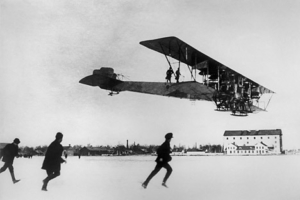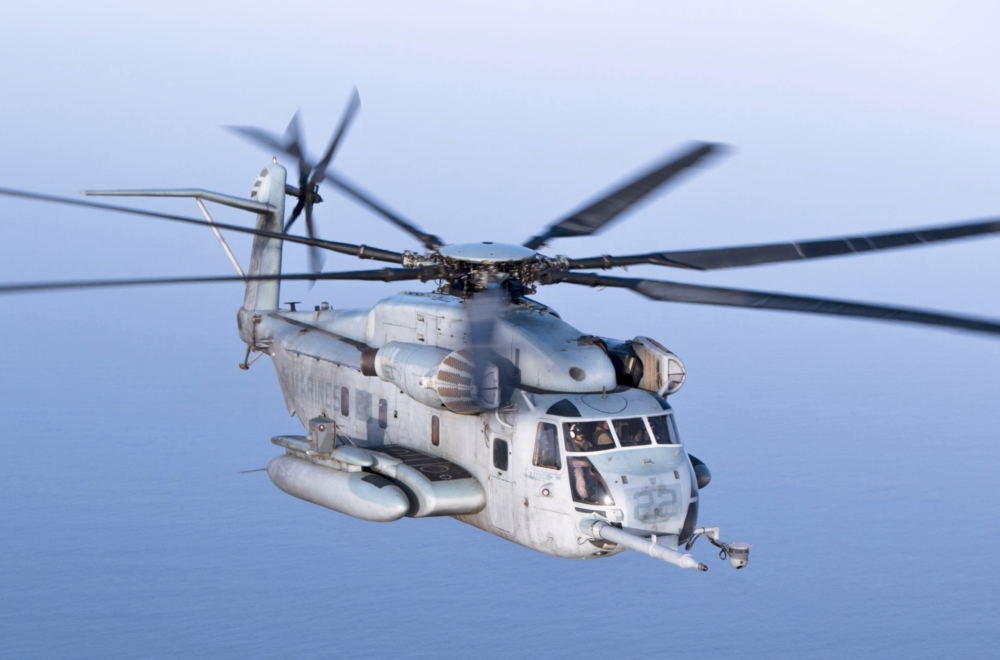Sikorsky in Connecticut
By: John Hax
Editors Note: John Hax played a role in the development of Sikorsky’s CH-53E Super Stallion

[If you have a Stratford story to share, we’d love to hear from you! Please contact [email protected] Articles will be edited for content and space.]
In the spring of 1999, I stood waiting at the Milford Metro North station to greet two visitors who were visiting Connecticut and, in fact, the USA, for the first time. They represented the Moscow Museum of Science and were here to collect material for a major exhibit celebrating the work of Igor Sikorsky, the distinguished aviation pioneer.
When my visitors stepped off the train, it might have been from a time machine. They were a man and a woman, perhaps in their fifties, dressed as we might have been in the 1940s. Both were intelligent, both spoke excellent English, both were focused on why they were there. We hit it off instantly.
Sikorsky had been born and raised in the city of Kiev, son of a famous psychiatrist. When still a young man, he had created and flown many groundbreaking designs. A contemporary of the Wright Brothers, he did his work far from where others were doing the same, unable to share their knowledge, and yet this period of his life culminated in the world’s first four engine bomber, the Ilya Muromets. When open cockpits ala Snoopy were the prevailing standard, the closed cabin Muromets was bombing Germany positions in WW I very effectively. The cabin was heated. And none were lost in combat.
But during the 72 years of the Soviet Union’s existence, Sikorsky’s work went unrecognized behind the Iron Curtain and in fact largely unremembered. Igor and his family had been staunchly supportive of the Tsar and the White armies fighting for his restoration during the civil war following the 1917 October revolution. With the Reds’ victory, Igor left his homeland never to return. He died in 1972.
The Soviet Union followed him to the grave in stages during the next twenty years, and it wasn’t long before the name of Igor Sikorsky could once again be spoken openly in a voice above a whisper in a place once again called Russia. Hence the Moscow Museum of Science exhibit. Hence their interest in what he had achieved here.
I had little difficulty giving them everything they needed—copies of his blueprints and copies of wind tunnel models were made and shipped. But the most memorable part of the visit for me was the tour of the locations significant to Igor’s American life. They knew every one, and we visited them all. The Russian Orthodox Church in Stratford, the asphalt ramp down which his pioneering seaplane designs were rolled into the Housatonic River, the site of the VS-300’s first wobbly flight in 1939, Igor Sikorsky’s tomb, and more.
My visitors took many pictures which ended up wall-sized at their Moscow exhibit. For all I know I may have been in some. The last station of this cross was a visit to the current facility at North Main, ending with a visit to Igor’s office.
It has been kept for the past 50 years exactly as he had left it at the day before he died, his last letter still centered on his desk blotter. I have shown the office to a number of visitors, but none had expressed the reverence I saw that day.
They left with their museum exhibits secured, but their visit left a lot with me. In the noise of daily concerns I had lost that wonder at all that Igor Sikorsky had accomplished, but my Moscow visitors brought it back. They refreshed my awareness that Stratford and environs are an Igor Sikorsky theme park that few know about and fewer visit.
And this area is not the totality of it: there was a place called Utgoff Farm where Igor and his band of Tsarist émigrés made their first aircraft in America, where junked bed frames were turned to airframes, and where a chicken was killed each weekend for the dual purpose of providing a group dinner and retrieving rivets. When they ran out of money, they hit up Sergei Rachmaninov, even making him a vice president of Sikorsky Aircraft. Utgoff Farm isn’t on anyone’s visiting tour anymore: it now lies beneath La Guardia runways.
I was born in 1937 and grew up in Waterbury. The helicopter industry was born at roughly the same time and grew up in Stratford and Bridgeport. Tourists flock to Kitty Hawk, NC, to visit the birthplace of fixed-wing aviation, but the birthplace of rotary wing aviation is all around us—at lower Main St. in Stratford where the VS-300 first flew in 1939, and at South Avenue in Bridgeport, where the first models entered series production. The men who made it happen lie beneath Russian Orthodox tombstones in our local cemeteries, and their footsteps echo in the Russian Orthodox Church and place names like Russian Beach in Stratford. These are places we don’t visit with guide books in our hands. We should.
My story had merged with this narrative in 1963, when I completed flight training in the Naval Air Training Command and was designated a Naval Aviator. Even though I was a Lieutenant in the Marines, I was still a Naval Aviator.
When I joined Marine Air Group 36 in Santa Ana, CA, I transitioned to the UH-34D, again a Sikorsky product, which I flew for the remainder of my time on active duty in the USMC. Although the UH-34D was obsolete at the time, it got me back (relatively) unscathed from every mission. True love grows from such.
So I finished my 34 working years as a mission analyst at Sikorsky. While there, I made many visits to Mr. Sikorsky’s office. Each visiting military chopper pilot who was taken there asked to touch Igor’s black fedora hat for luck. Why, you ask? Because Igor Sikorsky not only designed and built his own helicopters, he test-flew them too. While wearing that hat. He crashed many times and survived them all. Why? Must have been the hat. Visitors can also admire a wall-mounted blackened tree branch, loser in an encounter with yet another test flight.
One cannot touch the hat now: from thousands of touchings over the years, disintegration began to raise its ugly head. It now rests serenely within a plastic case.
In many ways, Stratford is itself an Igor Sikorsky shrine. How widely is this known here? Hard to know. But I can tell you where it is known: Moscow.
John Hax had a role in the development of Sikorsky’s CH-53E Super Stallion.
The Ilya Muromets designed and tested by Igor Sikorsky in 1913.

